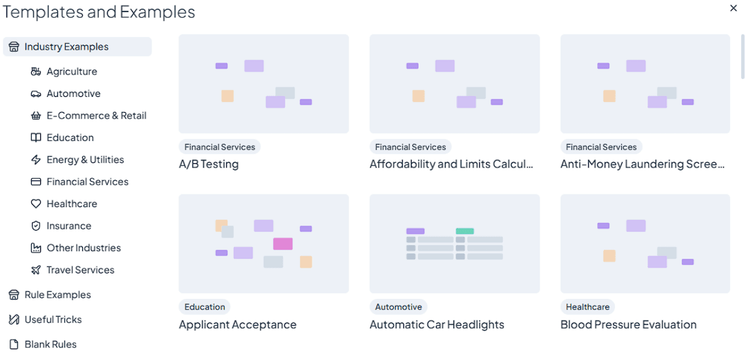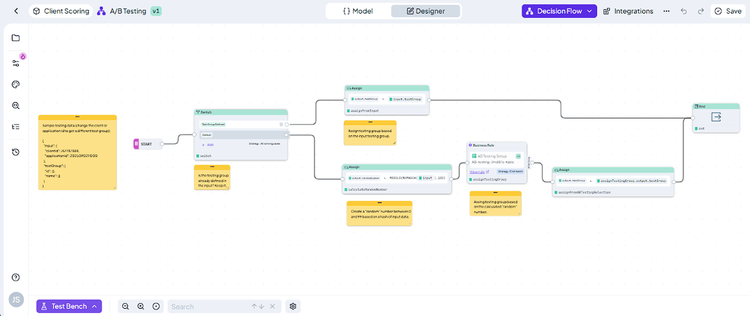Building business logic doesn't have to start from scratch. The DecisionRules template library offers a practical shortcut, providing pre-built starting points for common use cases. This guide covers everything you need to know, from browsing the library and selecting the right template to customizing and testing your new rule.
Explore Our Expanded Library of Industry-Specific Examples
Before building your next rule from scratch, it's worth browsing the template library. Each one is a ready-made starting point designed to give you a significant head start. They contain proven logic for common use cases across many industries, saving you development time and providing inspiration for your own projects.
Current categories include:
- Agriculture
- Automotive
- E-Commerce & Retail
- Education
- Energy & Utilities
- Financial Services
- Healthcare
- Insurance
- Travel Services
- Other Industries
Each template in these categories showcases realistic logic structures and data conditions tailored to typical use cases such as eligibility rules, risk assessments, pricing models, scoring evaluation, operational and more.
Whether you're working directly in one of these industries or just want to explore how decision logic is applied in different contexts, these templates are a great place to start.
How to Access and Use Templates in 3 Simple Steps
Getting started is straightforward. You can find and deploy a template in under a minute.
Step 1: Locate the Templates Hub
After logging in, you will land on your main Rule list. At the top of this list, look for the "Templates and Examples" card, which is marked with a large plus sign.

Step 2: Browse and Select Your Template
Clicking the card opens the Template Modal. In the left panel, you can browse categories like Industry Examples or Rule Examples. The main panel displays all the templates in that category. Hover over any card to see a description, and click the "Use Template" button to select it.

Step 3: Customize and Test Your New Rule
Once you click "Use Template," a new rule is instantly created in your space. This isn't just a copy of the logic; it's a complete, ready-to-use asset pre-packaged with everything you need:
- Pre-filled Logic: The core decision flow or table based on the template's design.
- Sample Test Data: Input data is included so you can immediately run a test.
- Fully Editable Structure: The entire rule is unlocked and ready for you to adjust, extend, or connect to your own data.

Your Path to Production
With your new rule created from a template, you are now in the designer, ready to tailor it to your exact requirements. The typical workflow is:
- Run an initial test using the built-in sample data to see it in action.
- Observe how the rule behaves and reacts to different inputs in the Test Bench.
- Adjust the logic and parameters to fit your specific use case.
- Replace the sample data with your own real-world inputs when you're ready to go live.

A Note on Test Data: Evaluation data from the Test Bench is temporary. To keep a permanent record of evaluations, use the Audit Logs feature, which automatically saves all test inputs and results. Learn more in our Documentation.
Key Takeaways for Working with Templates
To get the most value from the template library, think of it as a flexible toolkit designed to accelerate your work. Keep these best practices in mind:
- Use Them as Inspiration: Most templates are starting points. Feel free to change, extend, or simplify the logic to perfectly suit your needs.
- Accelerate Onboarding: Templates are an excellent tool for training new team members, as they provide practical examples of the rule engine's features.
- Mix and Match: Don't hesitate to borrow ideas and logic structures from multiple templates to build a completely custom solution for your project.
By integrating templates into your workflow, you shift from slow, manual rule creation to a rapid, scalable, and reliable decision management process.
Ultimately, templates are more than just a feature, they are a strategic asset. By using them as a foundation, you empower your team to move beyond manual rule creation and adopt a rapid, scalable, and reliable decision management process.

Jana Sprušilová
Consultant Tester
